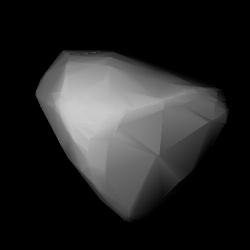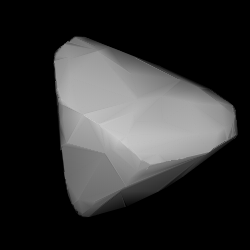Related Research Articles

944 Hidalgo is a centaur and unusual object on an eccentric, cometary-like orbit between the asteroid belt and the outer Solar System, approximately 52 kilometers in diameter. Discovered by German astronomer Walter Baade in 1920, it is the first member of the dynamical class of centaurs ever to be discovered. The dark D-type object has a rotation period of 10.1 hours and likely an elongated shape. It was named after Mexican revolutionary Miguel Hidalgo y Costilla.
1373 Cincinnati, provisional designation 1935 QN, is an asteroid in a comet-like orbit from the Cybele region, located at the outermost rim of the asteroid belt, approximately 20 kilometers in diameter. It was the only asteroid discovery made by famous American astronomer Edwin Hubble, while observing distant galaxies at Mount Wilson Observatory in California on 30 August 1935. The rather spherical X-type asteroid has a rotation period of 5.3 hours. It was named for the Cincinnati Observatory.

251 Sophia is a stony background asteroid from the outer regions of the asteroid belt. It was discovered on 4 October 1885, by astronomer Johann Palisa at the Vienna Observatory in Austria. The S-type asteroid (S/L) has a rotation period of 20.2 hours and measures approximately 28 kilometers in diameter. It was named after Sophia von Seeliger, wife of German astronomer Hugo von Seeliger (1849–1924).
20461 Dioretsa is a centaur and damocloid on a retrograde, cometary-like orbit from the outer Solar System. It was discovered on 8 June 1999, by members of the LINEAR team at the Lincoln Laboratory Experimental Test Site near Socorro, New Mexico, United States. The highly eccentric unusual object measures approximately 14 kilometers in diameter. It was named Dioretsa, the word "asteroid" spelled backwards.

748 Simeïsa is a very large Hilda asteroid from the outermost regions of the asteroid belt, approximately 104 kilometers in diameter. It was discovered on 14 March 1913, by Russian astronomer Grigory Neujmin at the Simeiz Observatory on the Crimean peninsula. The dark P-type asteroid has a rotation period of 11.9 hours and a shape that is reminiscent of a tetrahedron. It was the first asteroid discovery made in Russia and named after the discovering observatory and its nearby Crimean town, Simeiz.

909 Ulla is a large and dark asteroid from the outermost regions of the asteroid belt, that measures approximately 116 kilometers in diameter. It is the parent body and namesake of the Ulla family, which belongs to the larger group of Cybele asteroids. It was discovered on 7 February 1919, by German astronomer Karl Reinmuth at the Heidelberg Observatory in southwest Germany. The X-type asteroid has a rotation period of 8.7 hours and a notably low value for its Jupiter Tisserand's parameter. It was named after Ulla Ahrens, daughter of a friend of the discoverer.
1952 Hesburgh, provisional designation 1951 JC, is a rare-type carbonaceous asteroid from the outer regions of the asteroid belt, approximately 37 kilometers in diameter.
1213 Algeria, provisional designation 1931 XD, is a carbonaceous asteroid from the outer region of the asteroid belt, approximately 32 kilometers in diameter. Discovered by Guy Reiss at Algiers Observatory in 1931, it was named after the North African country of Algeria.
5144 Achates is a large Jupiter trojan from the Trojan camp, approximately 90 kilometers in diameter. It was discovered on 2 December 1991, by American astronomer Carolyn Shoemaker at the Palomar Observatory in southern California, United States. The assumed C-type asteroid has a rotation period of 6 hours, a notably eccentric orbit of 0.27, and belongs to the 40 largest Jupiter trojans. It was named after Achates from Greco-Roman mythology.
4946 Askalaphus ( ə-SKAL-ə-fəs; prov. designation: 1988 BW1) is a Jupiter trojan from the Greek camp, approximately 52 kilometers (32 miles) in diameter. It was discovered on 21 January 1988 by American astronomer couple Carolyn and Eugene Shoemaker at the Palomar Observatory in California. The dark D-type asteroid belongs to the 100 largest Jupiter trojans and has a rotation period of 22.7 hours. It was named after Ascalaphus from Greek mythology.
1362 Griqua, provisional designation 1935 QG1 is a dark, Jupiter-resonant background asteroid on an eccentric, cometary-like orbit and the namesake of the Griqua group, located in the Hecuba gap in the outermost region of the asteroid belt. The carbonaceous asteroid measures approximately 28 kilometers (17 miles) in diameter and has a rotation period of 6.9 hours. It was discovered on 31 July 1935, by South-African astronomer Cyril Jackson at Union Observatory in Johannesburg. The asteroid was named after the Griqua people in South Africa and Namibia.

1693 Hertzsprung is a dark and elongated background asteroid from the middle region of the asteroid belt, approximately 39 kilometers in diameter. It was discovered on 5 May 1935, by Dutch astronomer Hendrik van Gent at the Leiden Southern Station, annex to the Johannesburg Observatory in South Africa.
3793 Leonteus is a large Jupiter trojan from the Greek camp, approximately 90 kilometers in diameter. It was discovered on 11 October 1985, by American astronomer couple Carolyn and Eugene Shoemaker at the Palomar Observatory in California, United States. The D-type Jovian asteroid belongs to the 30 largest Jupiter trojans and has a rotation period of 5.6 hours. It was named after the hero Leonteus from Greek mythology.

3451 Mentor is a large Jupiter trojan from the Trojan camp, approximately 120 kilometers in diameter. It was discovered on 19 April 1984, by Czech astronomer Antonín Mrkos at the Kleť Observatory in the Czech Republic. The uncommon Jovian X-type asteroid is one of the largest Jupiter trojans and has a rotation period of 7.7 hours. It was named after Mentor from Greek mythology. Mentor, a man who was rich in horse at Pedaeus. He was the father of the spearman Imbrius, an ally of the Trojans.
3688 Navajo, provisional designation 1981 FD, is a Griqua asteroid and a 2:1 Jupiter librator on an eccentric, cometary-like orbit from the outermost regions of the asteroid belt, approximately 6 kilometers in diameter. It was discovered on 30 March 1981, by American astronomer Edward Bowell at the Anderson Mesa Station near Flagstaff, Arizona. The dark P-type asteroid was named for the Native American Navajo people.

1484 Postrema, provisional designation 1938 HC, is a carbonaceous Postremian asteroid and namesake of the Postrema family from the central regions of the asteroid belt, approximately 41 kilometers in diameter. It was discovered on 29 April 1938, by Soviet astronomer Grigory Neujmin at the Simeiz Observatory on the Crimean peninsula. The name "Postrema" celebrates the astronomer's last minor planet discovery.
1922 Zulu, provisional designation 1949 HC, is a carbonaceous asteroid in a strongly unstable resonance with Jupiter, located in the outermost regions of the asteroid belt, and approximately 20 kilometers in diameter. It was discovered on 25 April 1949, by South African astronomer Ernest Johnson at Union Observatory in Johannesburg, and named for the South African Zulu people.
(457175) 2008 GO98, provisional designation 2008 GO98 with cometary number 362P, is a Jupiter family comet in a quasi-Hilda orbit within the outermost regions of the asteroid belt. It was discovered on 8 April 2008, by astronomers of the Spacewatch program at Kitt Peak National Observatory near Tucson, Arizona, in the United States. This presumably carbonaceous body has a diameter of approximately 15 kilometers (9 miles) and rotation period of 10.7 hours.
(20729) 1999 XS143 (provisional designation 1999 XS143) is a Jupiter trojan from the Greek camp, approximately 51 kilometers (32 miles) in diameter. It was discovered on 15 December 1999, by American astronomer Charles Juels at the Fountain Hills Observatory in Arizona. The dark Jovian asteroid has a short rotation period of 5.72 hours and belongs to the 90 largest Jupiter trojans. It has not been named since its numbering in January 2001.
(23958) 1998 VD30 (provisional designation 1998 VD30) is a Jupiter trojan from the Greek camp, approximately 47 kilometers (29 miles) in diameter. It was discovered on 10 November 1998, by astronomers with the LINEAR survey at the Lincoln Laboratory's Experimental Test Site near Socorro, New Mexico, in the United States. The dark Jovian asteroid belongs to the 110 largest Jupiter trojans and shows an exceptionally slow rotation of 562 hours. It has not been named since its numbering in April 2001.
References
- 1 2 3 4 5 6 "20898 Fountainhills (2000 WE147)". Minor Planet Center. Retrieved 10 April 2018.
- 1 2 3 4 5 "JPL Small-Body Database Browser: 20898 Fountainhills (2000 WE147)" (2018-01-24 last obs.). Jet Propulsion Laboratory . Retrieved 10 April 2018.
- 1 2 3 4 5 6 7 "LCDB Data for (20898) Fountainhills". Asteroid Lightcurve Database (LCDB). Retrieved 8 December 2017.
- 1 2 "Small Bodies Data Ferret". Nesvorny HCM Asteroid Families V3.0. Archived from the original on 2 August 2017. Retrieved 8 December 2017.
- 1 2 3 4 Licandro, J.; Alvarez-Candal, A.; de León, J.; Pinilla-Alonso, N.; Lazzaro, D.; Campins, H. (April 2008). "Spectral properties of asteroids in cometary orbits" (PDF). Astronomy and Astrophysics. 481 (3): 861–877. Bibcode:2008A&A...481..861L. doi: 10.1051/0004-6361:20078340 . Retrieved 8 December 2017.
- 1 2 3 4 Tedesco, E. F.; Noah, P. V.; Noah, M.; Price, S. D. (October 2004). "IRAS Minor Planet Survey V6.0". NASA Planetary Data System. 12: IRAS-A-FPA-3-RDR-IMPS-V6.0. Bibcode:2004PDSS...12.....T . Retrieved 22 October 2019.
- 1 2 3 4 Licandro, J.; Alí-Lagoa, V.; Tancredi, G.; Fernández, Y. (January 2016). "Size and albedo distributions of asteroids in cometary orbits using WISE data". Astronomy and Astrophysics. 585: 12. arXiv: 1510.02282 . Bibcode:2016A&A...585A...9L. doi:10.1051/0004-6361/201526866.
- 1 2 3 Holliday, B. (June 2001). "Photometry of Asteroid 251 Sophia, 393 Lampetia, and (20898) 2000 WE147, September 2000 through January 2001". The Minor Planet Bulletin. 28: 26–28. Bibcode:2001MPBu...28...26H.
- 1 2 3 Ye, Q.-z. (February 2011). "BVRI Photometry of 53 Unusual Asteroids". The Astronomical Journal. 141 (2): 8. arXiv: 1011.0133 . Bibcode:2011AJ....141...32Y. doi:10.1088/0004-6256/141/2/32.
- ↑ "MPC/MPO/MPS Archive". Minor Planet Center. Retrieved 10 April 2018.